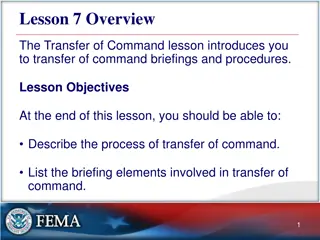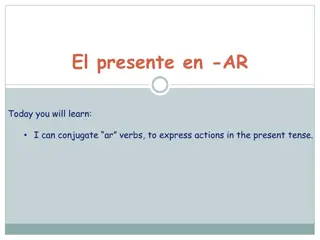Spanish Command Forms and Conjugations Simplified
Explore the nuances of command forms in Spanish with a focus on usted, ustedes, and nosotros conjugations. Learn the 3-step process to form commands, including irregularities and examples for clarity.
Download Presentation

Please find below an Image/Link to download the presentation.
The content on the website is provided AS IS for your information and personal use only. It may not be sold, licensed, or shared on other websites without obtaining consent from the author.If you encounter any issues during the download, it is possible that the publisher has removed the file from their server.
You are allowed to download the files provided on this website for personal or commercial use, subject to the condition that they are used lawfully. All files are the property of their respective owners.
The content on the website is provided AS IS for your information and personal use only. It may not be sold, licensed, or shared on other websites without obtaining consent from the author.
E N D
Presentation Transcript
OTHER COMMAND FORMS Avancemos 3 Unidad 2 Lecci n 1
COMMAND FORMS: In English, commands almost always stay the same. Stop! is Stop! regardless of who you are speaking to. In English when you include yourself in a group (we), you simply add let s in front of the verb to form the command: In Spanish, there are more variations of the command form. In this PowerPoint, we will look at the usted/ustedes/nosotros command forms: Example: Stop! (command in English) = in Spanish Para! (t command) Pare! (usted command) Paren! (ustedes command) BUT Paremos! = Let s stop! (nosotros command)
OTROS MANDATOS: So far we have learned how to construct affirmative and negative commands with t We also need to know the command forms used with usted / ustedes and nosotros . The good news is once you know how to conjugate a negative t command, usted, ustedes, and nosotros commands are easy!! You follow the same 3 step process as for negative t commands but use a different opposite ending
USTED AND USTEDES COMMANDS: The 3 step process: 1. Go to the YO form 2. Drop the o 3. Add the opposite ending (For AR verbs either e (usted) or en (ustedes) (For ER/IR verbs either a (usted) or an (ustedes) Example 1: Tirar Yo tiro (No) tire! (No) tiren! Example 2: Comer Yo como (No) coma! (No) coman!
NOSOTROS COMMANDS The 3 step process: 1. Go to the YO form 2. Drop the o 3. Add the opposite ending (For AR verbs use emos) (For ER/IR verbs use amos) Example 1: Tirar Yo tiro (No) tiremos! Example 2: Comer Yo como (No) comamos! *******To make any of these commands (usted, ustedes, nosotros) negative, you simply add a NO in front of the command. YOU DON T HAVE TO CHANGE ANYTHING ELSE. The nosotros command translates as Let s .. In English
SIDES IRREGULAR T COMMANDS As with t commands, the same irregulars apply here. If there is an irregular yo form, the usted/ustedes/nosotros commands will also be irregular: We also see the same irregular SIDES verbs: S ser sea/sean/seamos I ir vaya/vayan/vamos BUT** no vayamos D dar d /den/demos E estar - est /est n/estemos S sepa/sepan/sepamos ** exception To say Let s go , use Vamos! BUT To say Let s not go , use vayamos
CAR/GAR/ZAR VERBS As with the negative t commands, verbs that end in CAR/GAR/ZAR will require a spelling change in the usted/ustedes/nosotros commands (c-qu, g-gu, z-c): Buscar: Yo busco - busque!/ busquen!/ busquemos! Organizar: Yo organizo - organice!/ organicen!/ organicemos! Jugar: Yo juego - juegue!/ jueguen!/ juguemos!
UNA PRCTICA Don t delegate (Uds.) No deleguen 1. 1. Give (Ud.) D ! 2. 2. Be nice (Uds.) Sean amables! 3. 3. Let s go Vamos! 4. 4. Don t play (Uds.) No jueguen! 5. 5. Start (Ud.) Empiece! 6. 6. Take out (Uds.) Saquen! 7. 7. Let s not change No cambiemos! 8. 8.

 undefined
undefined





























